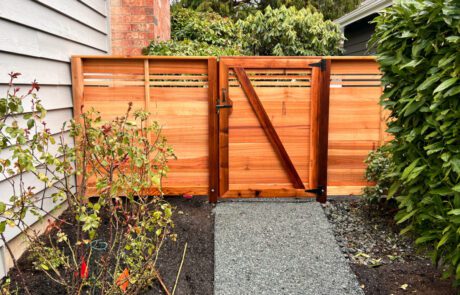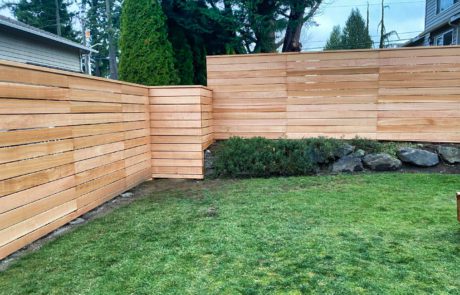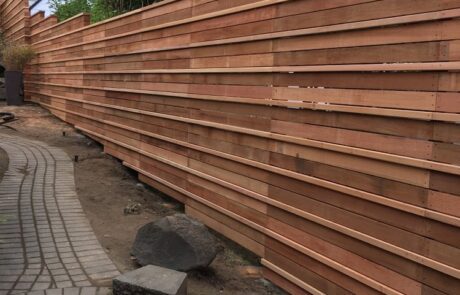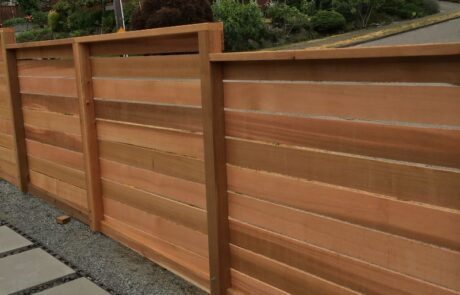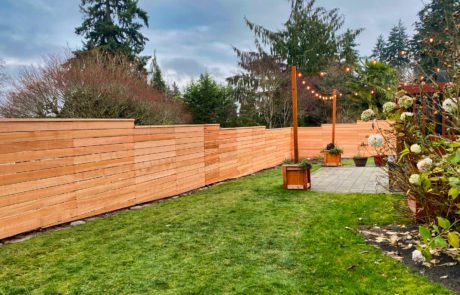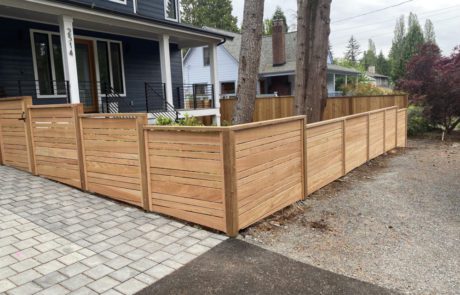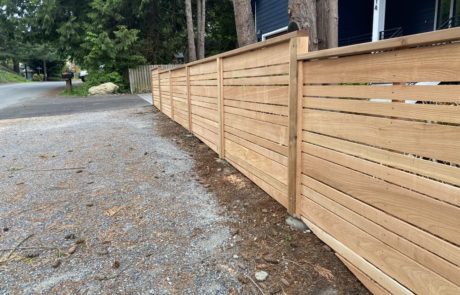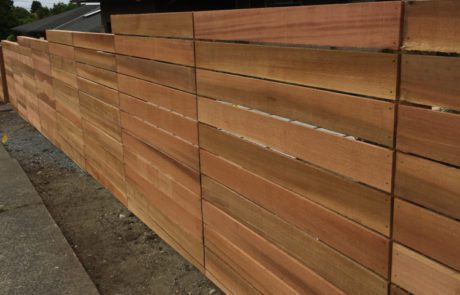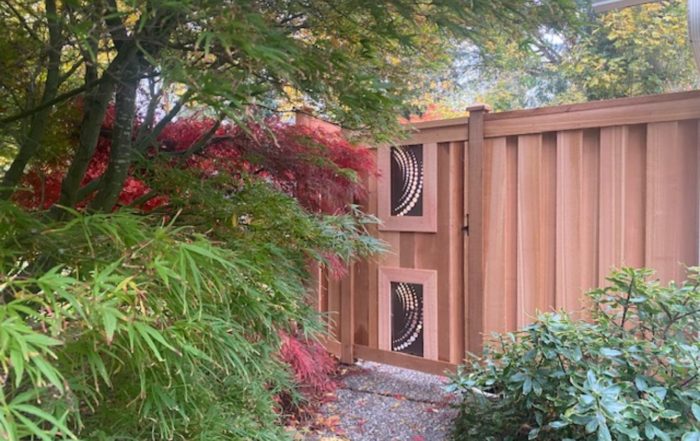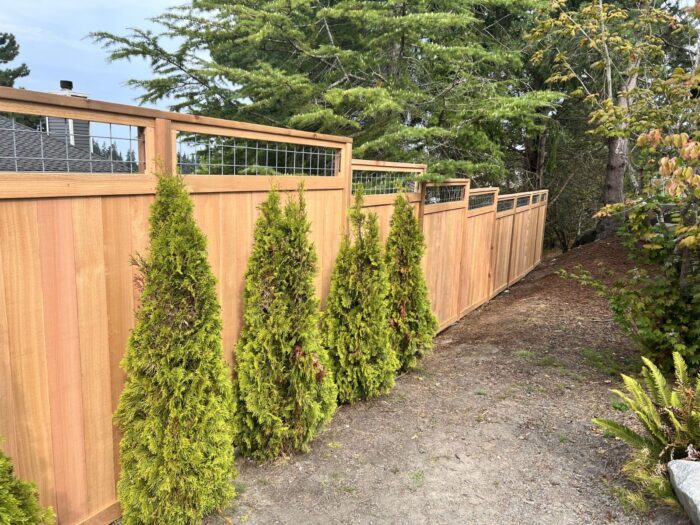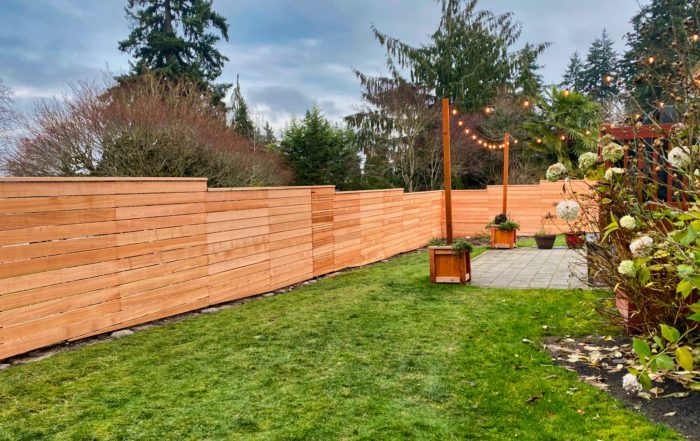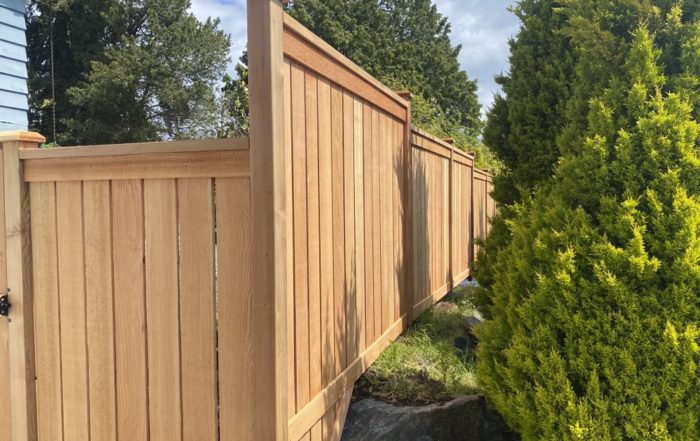Seattle, a city known for its scenic beauty and unique architectural preferences, is increasingly favoring horizontal wood fences for home properties. The shift in favor from traditional vertical fences to horizontal wood fences can be credited to a variety of factors that are as unique as the city itself...
Why Seattle Homeowners Are Choosing Horizontal Wood Fences
Seattle, a city known for its scenic beauty and unique architectural preferences, is increasingly favoring horizontal wood fences for home properties. The shift in favor from traditional vertical fences to horizontal wood fences can be credited to a variety of factors that are as unique as the city itself.
The Rising Popularity of Horizontal Wood Fences
The popularity of horizontal wood fences has surged in recent years. There’s a certain modern aesthetic that this style brings, blending harmoniously with the natural, outdoorsy vibe that Seattle is famous for. In addition, horizontal fences provide a unique way to showcase the vibrant hues and textures of wood, particularly Western Red Cedar, making them an attractive choice for homeowners who want to stand out from the standard vertical fences.
The versatility of horizontal wood fences is another point in their favor. They can be used to create unique patterns, adding visual interest, and increasing curb appeal. This sense of individuality, along with the functionality and aesthetic advantages, has significantly contributed to the rising popularity of horizontal wood fences in Seattle and beyond.
Why Seattle?
Now, you might wonder, why has Seattle, in particular, embraced the horizontal wood fence trend so eagerly? The answer lies in the city’s culture and climate.
Seattle’s residents have a deep appreciation for nature and the outdoors. This affinity extends to their homes, where they seek to incorporate natural elements into their design choices. Horizontal wood fences, with their organic textures and tones, perfectly align with this ethos, providing an opportunity to bring a touch of nature right into their backyards.
Moreover, the moist and temperate climate of Seattle makes it a suitable environment for wood fences. With proper maintenance and treatments, wood fences can withstand Seattle’s weather conditions and remain in good shape for years.
Lastly, the innovative spirit of Seattle’s homeowners cannot be discounted. Always eager to set trends rather than follow them, these residents have embraced the fresh, modern aesthetic of horizontal wood fences, setting the city apart in yet another unique way. In a city like Seattle, where the extraordinary is the ordinary, the growing appeal of horizontal wood fences seems to be just another extension of its exceptional spirit. Sky Fence, with its expertise in Western Red Cedar fences, is one such company that’s making waves in this space.
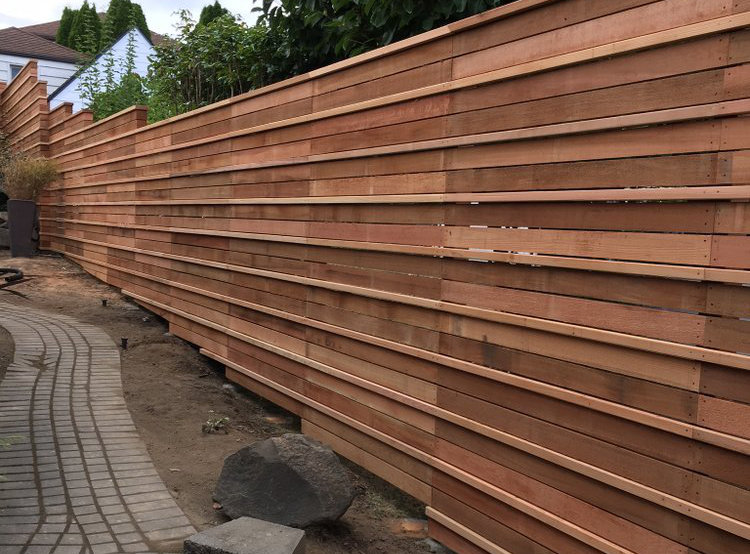
Key Features of Horizontal Wood Fences
Horizontal wood fences have garnered significant popularity for their distinctive and appealing characteristics. A tasteful blend of functionality and aesthetics, these fences serve as both protective barriers and statement pieces for your home.
The Design Flexibility
One of the most attractive features of horizontal wood fences is their design flexibility. They can be customized in a myriad of ways, from the spacing between the planks to the direction of the boards. You can opt for a uniform look with evenly spaced boards, or you can choose an alternating pattern for a more dynamic appearance.
The Contemporary Look
Next is the modern appeal. Unlike their vertical counterparts, horizontal fences exude a fresh, contemporary aesthetic that blends seamlessly with various architectural styles. Whether your home is a modern minimalist design or a traditional craftsman, a horizontal wood fence can provide that stylish finishing touch.
Showcasing the Wood’s Natural Beauty
Additionally, horizontal wood fences are an excellent medium to display the intrinsic beauty of wood grains. When the planks are positioned horizontally, they can truly highlight the unique patterns, tones, and textures of the wood, transforming the fence into a work of art. This characteristic makes them a preferred choice for showcasing the rich, warm hues of specialty woods like western red cedar.
Promotes Landscape Integration
Moreover, horizontal wood fences encourage landscape integration. Their linear design draws the eye along the length of the fence, enhancing the sense of continuity and flow within your garden or yard. This feature is especially beneficial for properties with spectacular views as it ensures that the fence doesn’t obstruct the scenery.
Practical and Functional
Beyond aesthetics, horizontal wood fences also offer practical functionality. They are sturdy and durable, standing up to strong winds better than vertical fences because the force is distributed more evenly. Furthermore, they provide excellent privacy without sacrificing on style, making them a smart choice for homeowners who want the best of both worlds.
In sum, the key features of horizontal wood fences – design flexibility, contemporary appeal, showcasing of wood’s natural beauty, landscape integration, and practical functionality – all contribute to their increasing popularity among homeowners. These fences not only enhance the aesthetic value of a home but also offer a high degree of personalization, strength, and privacy. No wonder they’re becoming a top choice for homeowners in cities like Seattle.
Horizontal vs Vertical Wood Fences: The Pros and Cons
When it comes to deciding between horizontal and vertical wood fences, both come with their own set of advantages and disadvantages. Weighing the pros and cons of each can help homeowners make an informed decision that suits their needs and aesthetic preferences.
Vertical Wood Fences
Pros
- Traditional Appeal: Vertical wood fences have been around for centuries, offering a timeless, classic aesthetic that blends well with many architectural styles.
- Privacy: They are excellent at providing privacy as they can be built tall with closely set boards, making it difficult for onlookers to see through.
- Easy Installation: Vertical fences are generally easier and faster to install because they follow the natural upright direction of the posts.
Cons
- Limited Design Options: Vertical wood fences, while beautiful, offer fewer design variations compared to horizontal ones, which might limit homeowners looking for a more unique or contemporary aesthetic.
- Maintenance: Over time, vertical boards can warp or twist, and they may require regular maintenance to keep them looking their best.
Horizontal Wood Fences
Pros
- Modern Appeal: Horizontal fences are in tune with modern design trends, offering a clean, contemporary look that stands out.
- Enhanced Space Perception: By drawing the eye along the length of the fence, horizontal fencing can make a property appear larger.
- Customizable: They allow for more design flexibility with different board sizes, spacing, and patterns, enabling homeowners to create a fence that truly reflects their style.
Cons
- Complex Installation: The installation process for horizontal fences is generally more complicated than for vertical ones. It requires more precision to ensure the boards are level and evenly spaced.
- Cost: Due to their unique installation requirements, horizontal fences can be more expensive than vertical fences, both in terms of materials and labor.
Both horizontal and vertical wood fences have their own charm and functionality. The choice between the two often depends on the homeowner’s personal preference, budget, and the specific requirements of their property. It’s all about finding the balance between aesthetics, practicality, and cost.
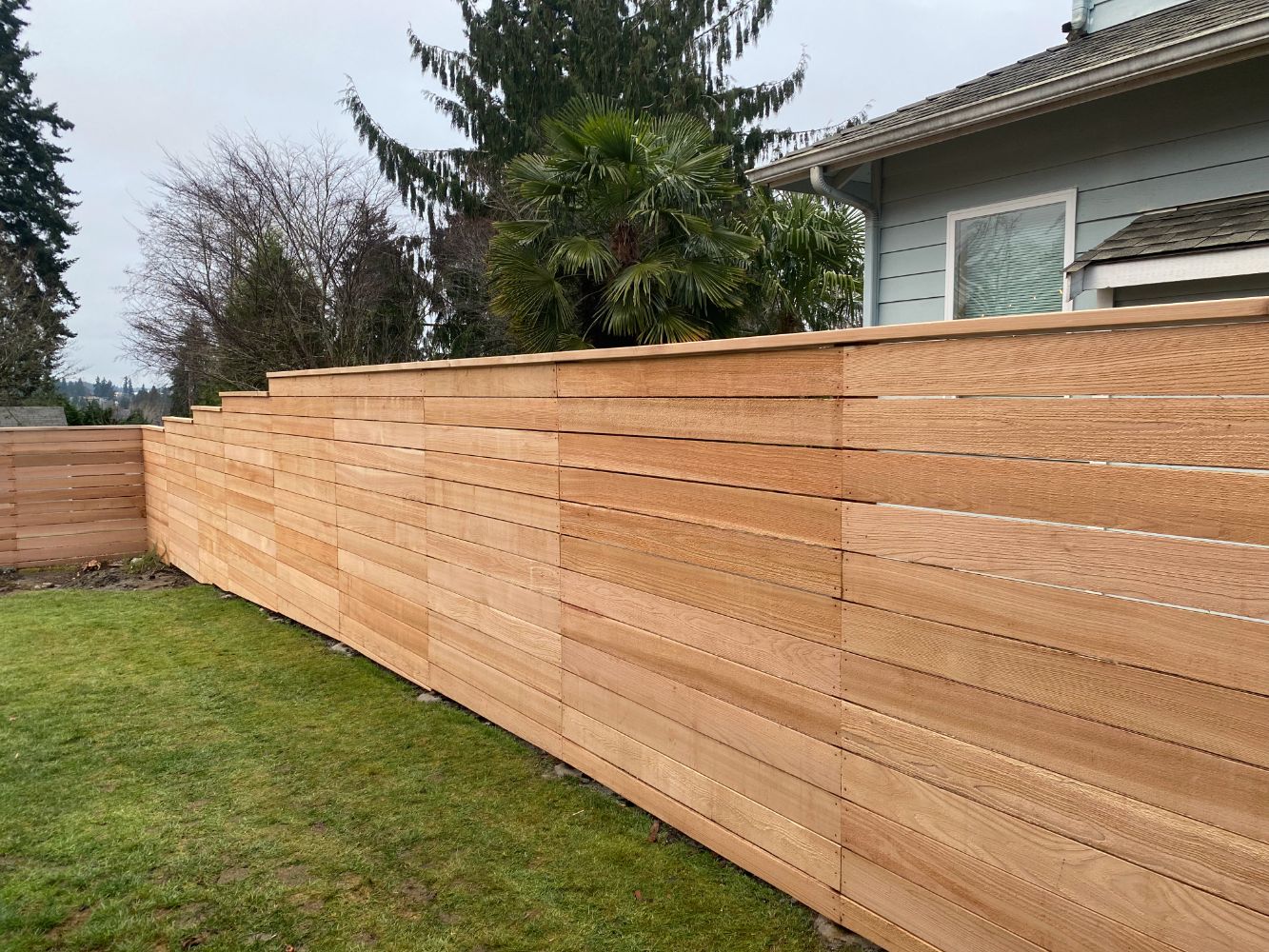
Top Horizontal Fencing Trends in Seattle for 2023
As we journey further into 2023, several captivating trends are emerging in the world of horizontal fencing in Seattle. These trends lean towards creating more visually appealing, eco-friendly, and functional spaces that resonate with the city’s unique aesthetic and climate conditions.
The first major trend revolves around integrating natural elements. The growing desire to foster a connection with nature has led homeowners to seek fence designs that blend seamlessly with their surrounding landscape. This includes using raw, untreated woods like cedar, which not only showcase beautiful, natural textures and colors, but also provide excellent durability. The grains of such woods become the spotlight when arranged horizontally, offering an organic, rustic charm.
Secondly, the customization trend continues to gain traction. Homeowners are veering away from uniform looks and experimenting with varied board widths, spacing, and patterns. Mixing and matching wide and narrow boards or alternating the alignment of the boards (some flush, some protruding) are ways homeowners are injecting personality into their fences. These designs give the classic horizontal fence a unique twist, ensuring each fence tells its own story.
Lastly, sustainability is playing an increasingly important role in fencing choices. Eco-friendly treatments and finishes are preferred not only for their minimal environmental impact but also for their ability to enhance the wood’s natural resilience against Seattle’s weather. As more homeowners seek to reduce their environmental footprint, the shift towards sustainable practices in fence construction is a trend set to continue throughout 2023 and beyond.
Materials Used for Horizontal Fences in Seattle
The selection of material plays a significant role in the durability, aesthetics, and maintenance needs of a horizontal wood fence. In Seattle, where the climate can be a crucial factor in material choice, certain types of wood have gained popularity due to their natural resilience and aesthetic appeal.
Popular Wood Types
Among the popular choices, cedar stands out due to its natural resistance to decay and insect damage. Its ability to withstand Seattle’s wet climate, coupled with its beautiful reddish hue, makes it a favorite among homeowners. Moreover, the distinctive aroma of cedar is not only pleasant but also serves as a natural insect repellent.
In addition to cedar, pressure-treated pine is another popular choice. It’s not only cost-effective but also extremely durable, thanks to the preservatives forced into the wood fibers that help it resist decay and insect infestation.The Environmental Protection Agency provides further information on the safety and effectiveness of wood preservatives.
Essential Wood Treatments for Seattle’s Climate
Given Seattle’s unique climate, characterized by damp winters and dry summers, wood treatments play a crucial role in extending the lifespan of a fence. Weatherproofing treatments like sealants and stains can help protect the wood from moisture and UV damage.
Sealants, usually clear or lightly tinted, preserve the wood’s natural color while offering a layer of protection against moisture. Stains, on the other hand, give homeowners the option to alter the color of the fence while also providing a degree of water resistance and UV protection.
Choosing the right wood type and treatment is critical in ensuring that your horizontal wood fence can stand the test of time, retain its beauty, and require minimal maintenance, even in the face of Seattle’s varied climate conditions.
Installing a Horizontal Wood Fence in Seattle
The installation of a horizontal wood fence can be a rewarding project, whether it’s a DIY endeavor or a professionally contracted job. Both approaches come with their own pros and cons, and the choice largely depends on individual skills, time availability, and budget.
DIY or Professional Installation?
Going the DIY route can be a cost-effective solution, offering a sense of accomplishment. However, it requires a fair amount of skill, time, and dedication. Installing a horizontal fence requires precision to ensure the boards are level and evenly spaced, which can be challenging for beginners.
On the other hand, professional installation guarantees a well-constructed fence, done in a timely manner with minimal stress to the homeowner. Professionals are adept at handling any challenges that may arise during installation, and they often provide warranties for their work, ensuring peace of mind.
Key Steps for Installing a Horizontal Fence in Seattle
The process of installing a horizontal fence in Seattle can be broken down into several essential steps:
- Planning: The journey begins with thorough planning. This includes outlining the fence’s path, securing required permits, and selecting appropriate materials based on the climate and aesthetic preferences.
- Setting the Posts: After planning, the next step is to place the posts. They need to be securely set in the ground, ensuring they are level and spaced accurately.
- Attaching the Boards: Once the posts are firmly set, you can start attaching the horizontal boards. This requires a keen eye for detail, as the boards need to be level across the length of the fence, and any minor discrepancies can become glaringly visible.
- Sealing or Treating: The final step involves sealing or treating the fence to safeguard it against Seattle’s distinctive climate, ensuring the fence remains attractive and durable for years to come.
Whether you’re breaking out your toolset or hiring a team of professionals, the result will be a beautiful horizontal wood fence that enhances your property’s aesthetic and value.
Maintaining Your Wood Fence
The beauty of a horizontal wood fence doesn’t just lie in its aesthetics, but also its longevity, which can be significantly extended with proper maintenance. Regular upkeep not only ensures the visual appeal of your fence but also protects your investment.
Maintenance primarily involves cleaning and reapplying a protective sealant or stain every few years. Cleaning the fence helps remove dirt, mildew, and algae that can accumulate, especially during Seattle’s damp winters. Using a pressure washer set at a low psi can effectively do this job without damaging the wood. After cleaning, allow the fence to dry thoroughly before applying a new coat of sealant or stain. This protective layer shields the wood from harmful UV rays and moisture, further increasing the fence’s lifespan. If you spot any minor damages or loose boards during this process, immediate repair can prevent more extensive damage in the future.
A well-maintained fence can serve as a beautiful, functional boundary for many years, contributing significantly to your property’s curb appeal.
Cost Factors for Horizontal Wood Fences in Seattle
When planning for a horizontal wood fence, it’s essential to consider both the initial and long-term costs. A well-informed budget not only ensures a smooth installation process but also helps manage expectations and potential financial commitments in the future.
Initial Costs
The initial cost of a horizontal wood fence in Seattle primarily depends on the materials used, the fence’s size, and whether you opt for a DIY or professional installation. High-quality woods like cedar may cost more upfront but offer better durability and aesthetics. Conversely, pressure-treated pine, while less expensive initially, might require more frequent maintenance in the long run. Similarly, professional installations can add to the initial costs, but they usually come with the guarantee of a well-constructed fence that stands the test of time.
Long-term Costs
While the upfront costs are important, the long-term costs can also significantly impact the overall expenditure. This includes the cost of regular maintenance such as cleaning and resealing or re staining the wood every few years. Depending on the type of wood used, you might also need to plan for potential repairs or replacement of damaged sections over time.
A well-planned budget that covers both initial and long-term costs can help ensure your horizontal wood fence remains a cost-effective and valuable addition to your property.

Horizontal Wood Fence Design Options
Designing a horizontal wood fence provides a wealth of options to cater to your aesthetic preference, functional needs, and style of your property. Here are some of the design choices you might consider:
- Traditional Horizontal: This design features uniformly spaced planks placed side by side, creating a simple and clean look. It’s perfect for highlighting the breadth of your yard and lends an open, expansive feel to the space.
- Mixed Width Planks: Adding a contemporary twist, this design involves alternating between wide and narrow boards. The varying widths add a dynamic visual element to your fence, creating an intriguing pattern that’s sure to capture attention.
- Metal and Wood Fusion: For a fence that marries rustic charm with modern sleekness, consider integrating metal elements into your wood fence. Adding metal posts or frames to your wood fence creates a distinct, appealing contrast that sets your fence apart.
- Board-on-Board Design: This design is ideal for those who value privacy without compromising on style. Boards are overlapped to allow air and light to pass through while obstructing a direct view into your yard.
- Incorporating Vertical or Diagonal Elements: A horizontal fence doesn’t mean everything has to be linear. Adding vertical or diagonal elements in gates or fence sections can create a visually striking contrast, adding depth and interest to your design.
- Staggered Design: This modern, eye-catching style features boards of varying lengths, which are installed in a staggered pattern. This creates a look of movement and intrigue, breaking up the uniformity often associated with traditional fence designs.
- Shadow Box Design: This involves placing boards in an alternating pattern on either side of the fence rails. The result is a neighbor friendly fence that is the same on both sides, providing privacy yet allowing for airflow.
- Louvered Design: This design incorporates tilted slats or louvers, much like a set of blinds. It allows for control of sunlight and privacy while adding a unique visual interest to your fence.
- Horizontal Fence with Accent Top: This design adds an accent to the top of the fence, such as lattice work or a row of smaller, decorative planks. It’s a great way to add height and an artistic flair to your fence.
- Multi-Level Horizontal Fence: This design plays with levels, having some sections of the fence higher than others. This can create a unique, eye-catching design, particularly suited to properties with varied landscaping or slopes.
The design of your horizontal fence can be as simple or as elaborate as you like. The key is to choose a design that resonates with your personal style and complements the character of your home and landscape.
Conclusion: The Appeal of Horizontal Wood Fences in Seattle
To conclude, the appeal of horizontal wood fences in Seattle is undeniable. They embody a perfect blend of form and function, offering a contemporary aesthetic without compromising on durability or privacy. With their ability to make any outdoor space feel larger and more open, horizontal fences are a fantastic way to elevate the curb appeal of your home.
The versatility of design options ensures there’s a style to suit every homeowner’s taste. Whether you prefer the clean lines of traditional horizontal fencing or want to create a unique look with mixed-width planks or metal accents, your fence can be a true reflection of your style. Plus, the variety of wood types and treatments available means you can create a fence tailored to withstand Seattle’s unique climate.
Finally, the flexibility to choose between DIY installation or professional services makes horizontal wood fencing a viable option for a wide range of budgets and skill levels. And with proper maintenance, your horizontal wood fence can be a long-lasting, beautiful addition to your home.
In essence, the rising popularity of horizontal wood fences in Seattle is well justified. They offer a modern, stylish alternative to traditional fencing styles, proving that a fence can be more than just a boundary – it can be a design statement.
FAQs for Seattle’s Horizontal Wood Fences
What type of wood is best for horizontal fences in Seattle?
Western Red Cedar is often recommended due to its natural resistance to decay and insect attack. However, other types of wood, when treated properly, can also withstand Seattle’s unique climate conditions.
How often should I maintain my horizontal wood fence?
It’s generally recommended to clean and seal or stain your fence every 2-3 years. However, the exact frequency can depend on the type of wood used and the specific weather conditions in your area.
Can I install a horizontal wood fence myself?
Yes, DIY installation is possible if you have the necessary skills and tools. However, professional installation can ensure a high-quality finish and is often recommended for more complex designs.
How long does a horizontal wood fence last?
With proper maintenance, a well-constructed horizontal wood fence can last up to 20 years or more. The lifespan can vary depending on the wood type and the specific climate and soil conditions in your area.
Do horizontal wood fences provide enough privacy?
Absolutely. Horizontal fences can offer excellent privacy, especially with designs like the board-on-board or louvered style. The level of privacy can be customized based on the gap you choose between the boards.
What’s the cost of a horizontal wood fence?
The cost can vary greatly depending on factors such as the type of wood used, the complexity of the design, and whether you choose DIY or professional installation. Initial costs can be higher than traditional vertical fences, but many homeowners find the aesthetic and functional benefits well worth the investment.
Why are horizontal fences becoming so popular?
Horizontal fences have a modern appeal and can make a yard look bigger. They also offer great versatility in design and provide excellent privacy. The trend for horizontal fences also fits well with many of the contemporary and mid-century modern home styles found in Seattle.

